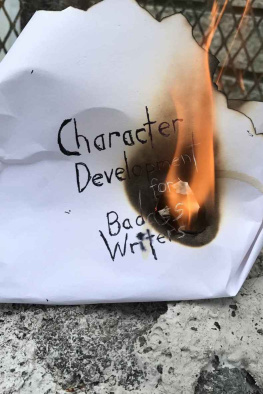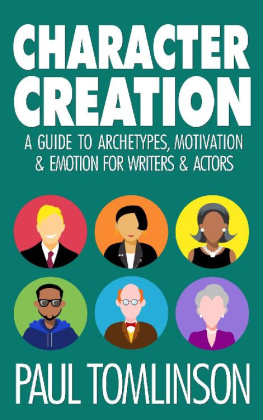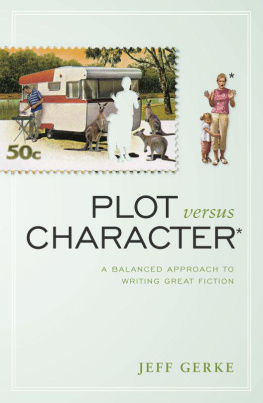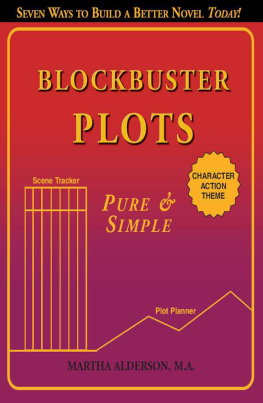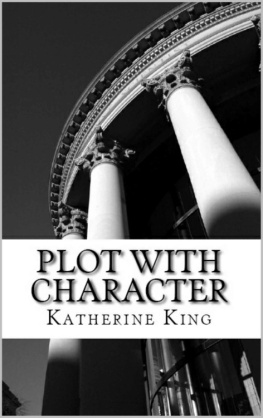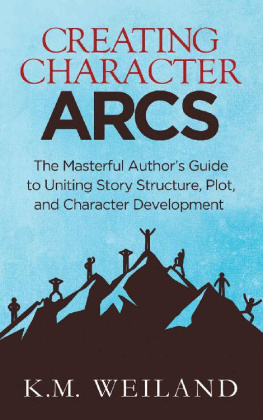
A Practical Guide to Character Creation and Development
by Jennie Jarvis
Published 2014 by Beating Windward Press LLC
For contact information, please visit:
http://www.BeatingWindward.com
Text Copyright Jennie Jarvis, 2014
All Rights Reserved
Book & Cover Design: Copyright KP Creative, 2014
Cover & Interior Illustrations by KP Creative
Author Photo by Tracy Reinhard
First Edition
ISBN: 978-1-940761-13-8
Introduction
Many writers think that, just because they have their basic structure in place, their stories are destined to succeed. The problem with many narratives, however, can often come in those places between the plot points. Ensuring the story is moving forward in every scene often comes in the shape of a character arc. While many books on the craft of writing state that characters need to be three dimensional and change, a beginning writer isnt always sure how to turn these rather conceptual ideas into something a bit more concrete.
Based on her acclaimed workshop, author Jennie Jarvis has penned Crafting The Arc. This essential guide for writers takes the conceptual idea of the character arc and creates a step-by-step, practical guide for beginning writers to use in order to ensure they create characters both dynamic and engaging. Using narrative examples from multiple platforms, including novels, films, plays and games, this is the essential guide for helping writers create an active and well-defined character arc.
Crafting The Character Arc is structured in three main parts. Part One will consist of a more traditional approach to creating character, including personalities, depth, secrets, goals versus emotional needs, active versus reactive protagonists, and dramatic functions. All of these more traditional ideas about discussing character will set the reader up for the new information and approach they will be introduced to in Part Two.
Part Two will introduce the reader to the Major Dramatic Curve, a detailed pictorial representation of a character arc. The rest of this section will dedicate one chapter to each element of the Major Dramatic Curve, using the narrative examples introduced in Part One to provide detailed demonstrations of how each element works in a larger narrative.
Part Three will focus on practical applications of the Major Dramatic Curve and some variations in its use. First, the writer will be given step-by-step guidance on using the Curve to help him/her in the creation of their narrative work. Then, as any writer can attest, there are always exceptions to any rule, and this section will address several of those exceptions. Part Three will end with a call to action for the reader.
The appendix of this textbook provides reference information for the narrative examples used throughout the text to demonstrate the concepts discussed. These narrative examples will come from multiple platforms (novels, films, games, plays and web series) in order to show the versatility of the concepts discussed. Finally, a glossary is included for a quick and user friendly review of all the terms defined throughout this textbook.
This textbook will be intended for the beginning or intermediate writer aspiring to work in any narrative driven forms of storytelling. With its step-by-step guide to creating a character arc, it could serve as a useful textbook in any high school, community college, University or community/adult education program that teaches narrative creative writing, including traditional Creative Writing, Game Design, Playwriting programs or Film Schools.
This textbook will also serve as a unique and refreshing approach to the veteran writer looking for a new take on an old concept. Since the primary approach of creating a character arc in this book is based on the well-known paradigm of Freytags triangle, it will also provide interest to any author who has studied this outdated concept and give them a new and modern approach to its use.
Part 1
Understanding Character
Whether a character in your novel is full of choler,
bile, phlegm, blood or plain old buffalo chips,
the fire of life is in there, too,
as long as that character lives.
James Alexander Thom
Chapter 1
Why Another Book On Character?
If you are anything like me, you are most likely a bit annoyed at the large number of craft books on creating character. I have at least a dozen of them, sitting on my shelf gathering dust or burning up space in my eReaders. I read through each of them once and then never felt the need to go back to them again.
Whether you write novels, short stories, film screenplays, television or games, the character books all read the same way. They explore how you can build a personality by looking at the characters past. They ask you develop character bibles or bios, indicating the name of the uncle who molested them when they were seven or diagnosing their PTSD or ADHD or some other mental health ailment. They remind you to make sure your character is fully developed and well rounded and other vague terms that we understand but arent completely sure how to execute in our own works.
Most of all, however, these books talk about how a character should change and grow. Who they are at the end needs to be someone different than who they were at the beginning. This seems to make sense. After all, if a character hasnt changed, then why did we bother to go on a journey with them to begin with?
But how do you get from point A to point B? How do you take the weakling child and turn her or him into the conquering hero? How do we take the character and pull them through their Arc?
This gap is where I get the most frustrated with my character craft books. I know where to begin, and I know where I want to end, but I dont always know the road in between. And those books do very little to help me along the way.
My frustration mostly comes from the fact that I was spoiled rotten when it came to learning plot development. My formal training came from screenwriting. Most non-film school students dont realize that writing for the movies is a very detailed and structured process. Screenwriters are given very defined guidelines for how their stories must be written. For years, the guidelines came from American screenwriting guru Syd Field. His book Screenplay (1979) pioneered the use of the Three Act Structure in American screenwriting. Basically just an updated version of the beginning-middle-end structure Aristotle discussed in The Poetics , Fields Three Act Structure breaks down the proportions of a films plot into four sections.

The first thirty pages of a screenplay were considered Act One. Also known as The Setup or Exposition, this section introduces the main characters and conflict of the story. Here, we meet the protagonist and see him/her begin his/her quest for the goal. This is also where we learn what the genre of the film will be. At the end of this Act, a major Plot Point (called Plot Point One) occurs which heightens the stakes for the protagonist and really kicks off the main storyline.
The most famous Act One to Act Two change of all time can be seen in the classic film The Wizard of Oz . In Act One of the film, we meet Dorothy Gale, a bored teenager anxiously awaiting the start her life away from the farm on which she grew up. After a mean woman tries to put her precious dog Toto to sleep due to an off-screen incident of aggression, Dorothy and her dog run away from home. On the road, she meets a fortune teller who prophesizes her aunt is sick and might be dying. Dorothy turns around and runs home, but a powerful tornado hits the farm, transporting her and her dog to another world. Plot Point One is when Dorothy opens her front door and discovers she has arrived in a new world. This Act break is extremely famous because the film changes from black and white to vibrant color.
Next page

